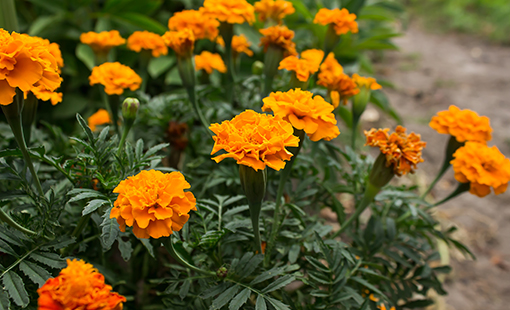
Growing Marigolds
Marigolds are cheerful, compact annuls with flower shapes that can resemble daisies, coreopsis and even carnations. Although native to Mexico, you can grow marigold plants virtually anywhere. They are widely adaptable and extremely low-maintenance. They also grow quickly and can be direct-seeded after the last frost in spring for a summer of bright blooms.
Types of Marigolds
There are several species and divisions of marigold. Most are modest in height, but there is a good amount of variety among the different types. You can find short bedding marigolds that grow only 4 to 6 inches tall and taller varieties that can reach 18 inches and make nice cutting flowers. The three most commonly grown types are African, French and signet marigolds.
African Marigolds
With large, pom-pom flowers on either compact or relatively tall plants, African marigolds are popular for both the border and as cut flowers. They can grow over 2 feet tall and have flowers that are 5 inches across. Colors include yellow and orange, although it’s not unlikely there will be a red option at some point.
French Marigolds
French marigolds are prized for their long, prolific blooms. They tend to be short, bushy plants, although they can grow from 5 to 18 inches tall. They have purple-tinged stems with double flower heads in yellow, orange and mahogany that are about 2 inches across.
Signet Marigolds
The edible marigolds are the signets. They look totally different from bedding marigolds, with lacy leaves and small, single, daisy-like flowers. They come in yellow and orange, with fitting cultivar names like ‘Orange Gem,’ ‘Tangerine Gem’, ‘Red Gem’ and ‘Lemon Gem’. There have been some hybrids on the market recently with an expanded palette of colors, such as shades of cream, burgundy and bi-colors, but the flavor is not always equal to that of the ‘Gem’ varieties.
How to Grow Marigolds
Marigolds are very low-maintenance once established, and they are notably pest-free. In fact, they are often used to keep pests away. Marigolds can bloom almost non-stop and will keep going all summer, until frost. To achieve that non-stop flowering, keep your marigolds deadheaded.
Light
For the most flowers and the healthiest plants, plant your marigolds in full sun.
Soil
Marigolds are not fussy. Any good garden soil (and a little water during dry spells) should keep them happy, as long as the soil is not too acidic. Keep the soil pH above about 6.0. They also don’t need a soil that is particularly rich in organic matter and seem to grow better in a leaner soil.
Water
When you first plant your marigold seeds or plants, make sure they get regular water. Don’t leave them in dry soil for more than a couple of days. If it is particularly hot and sunny, water them every day. Once they have had a few weeks to establish a good root system, they will be more drought-tolerant, but they will still bloom best if given weekly water.
Temperature and Humidity
Marigolds are some of the few garden flowers that are true annuals. Gardeners in all planting zones have to replant them every year. They tolerate a wide range of temperatures but can get powdery mildew in damp or humid summers. Planting in full sun and providing room for airflow will lessen this problem.
Fertilizer
Your marigolds won’t need any supplemental fertilizer unless your soil is extremely poor. The best thing you can do to keep them in flower is to deadhead regularly.
Landscape Uses for Marigolds
Marigolds make nice border plants, but their hot colors should be used with discretion. They work best with either other hot colors, like yellow and orange daylilies, or with complementary purples, like salvia and verbena. Because they are short plants, marigolds are generally used in the front of a border or in containers.
French marigolds are reputed to have some pest-repelling qualities and used to be considered an invaluable flower for the vegetable garden, but there is not a lot of evidence that they actually repel anything except nematodes. Still, they add a lot of color to the vegetable garden. You may have some luck planting marigolds around the edges of my vegetable garden, to deter rabbits.
Information courtesy of TheSpruce.com

 Adams Fairacre Farms
Adams Fairacre Farms